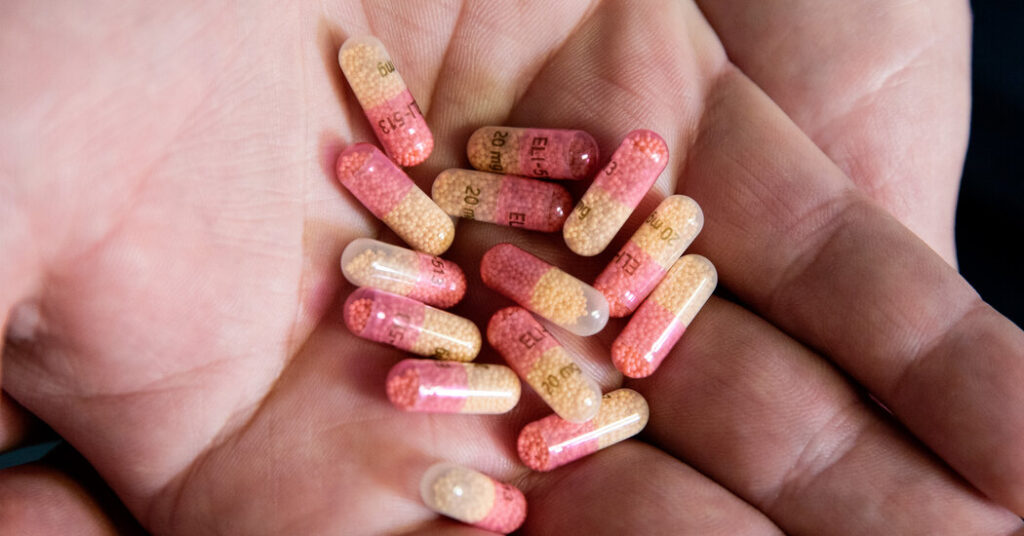Americans are confronting a shortage of several major drug treatments.
Some cancer patients are struggling to get chemotherapy drugs. Antibiotics are scarce after winter’s severe flu season. Medications for attention deficit hyperactivity disorder are in short supply. Even children’s Tylenol has been hard to find, as my colleague Christina Jewett wrote.
“This is, in my opinion, a public health emergency,” Dr. Amanda Fader of the Johns Hopkins School of Medicine said.
Today’s newsletter will focus on the A.D.H.D. medication shortage, which is reflective of many of the broader drug supply problems. The Food and Drug Administration first acknowledged the shortage in October. Patients complain that they have to shop around at pharmacies to get their medications, if they can find them at all. And without the drugs, many say they can’t function.
Edward DiNola, a game programmer and designer, told The Times that getting off the A.D.H.D. medication Adderall had made his sleep schedule piecemeal and unpredictable. After a week without the drug, he went to bed one day at 7 a.m. “It’s a bit of a curse to not have control over your own energy,” he said.
The broader shortages partly reflect supply chain problems for generic drugs, which make up 90 percent of prescriptions. But the A.D.H.D. medication shortage is more expansive in that it has hit brand-name products, like Adderall, as well. That has left more people without the drugs they need.
Rising demand
One reason for the A.D.H.D. medication shortage: The use of such drugs has surged in recent years. From 2020 to 2021, prescriptions increased more than 10 percent across many age groups, a recent C.D.C. study found.
Why? Experts point to the collision of two recent trends in the U.S.: the growing acceptance and acknowledgment of mental health issues, and policy changes brought on by the Covid pandemic that increased the use of telemedicine.
First, activists and policymakers have for decades pushed Americans to take mental health issues more seriously — to view them not as moral failings or character flaws, but as health problems that need treatment.
A.D.H.D. is an example of this acceptance. Experts long believed it mostly affected adolescent boys. In recent years, activists and patients have argued that A.D.H.D. can be a lifelong condition and that it is underdiagnosed and undertreated among girls and adults. Their view has gained ground, despite some criticisms that A.D.H.D. is already overdiagnosed in boys who are then treated with powerful, potentially dangerous stimulants.
Second, telemedicine got a big boost during the pandemic, as policymakers and medical facilities tried to limit in-person doctor visits. The shift not only allowed existing patients to continue getting treatment, it also allowed treatment for new patients who might not have made the trip to a doctor’s office or a hospital before.
These two trends acted together to increase demand for A.D.H.D. medications. As more people started to take their mental health more seriously, they had greater access to treatment. So more got on medications for A.D.H.D.
Supply chain problems
Beyond demand, several issues have potentially constrained the supply chain. Drug companies claim that government-set quotas have hindered supply, although the Drug Enforcement Administration has said that companies have not fully used what they have. Some pharmacies also argue that tougher rules for opioid painkillers have spilled over to other drugs, making it harder to get the supply they need.
For generic drugs, there is a more systemic problem. The companies are under constant pressure to offer the lowest prices possible, and they often cut corners to reduce costs and keep prices low. That leaves them unprepared to increase supply as needed if, for example, demand rises.
All of these factors are probably playing some role in the A.D.H.D. medication shortage, said Erin Fox, a drug supply chain expert at the University of Utah. But because much of the drug supply chain is opaque, it is difficult to know what, exactly, is going wrong.
The lack of transparency is itself a problem, not only for A.D.H.D. medications but for other drug shortages. If the public and policymakers don’t know what’s going wrong, they can’t help find a solution.
For more: Drug shortages will probably get worse, experts say.
THE LATEST NEWS
Politics
International
An ancient treasure
An ancient book known as the Codex Sassoon — the oldest known near-complete Hebrew Bible — sold for $38 million yesterday. Even in its own time, the book was an expensive object, requiring the skins of more than 100 animals to create its parchment leaves. Experts thought it might become the most expensive book over sold, but it fell short of the record set two years ago by the sale of a first printing of the U.S. Constitution.
PLAY, WATCH, EAT
What to Cook
What to Watch
The documentary “Anna Nicole Smith: You Don’t Know Me” is short on insight.


